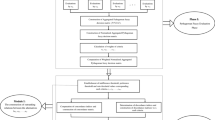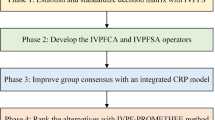Abstract
This article develops a group decision support scheme that extends the widely accepted ELECTRE-II model to the Pythagorean fuzzy (PF) context. ELECTRE-II takes into consideration subjective human opinions, and establishes two types of embedded outranking relations which yield a complete preference ordering of actions. Its variants under different models have produced a considerable number of applications. Keeping in view the stronger capability of PF model to handle uncertain information, a group decision support algorithm, named as PF-ELECTRE-II is presented for opinions in the adaptable PF structure. A first phase aggregates the PF opinions of the experts on each alternative and criteria with the aid of suitable PF aggregation operators. Then, the algorithm introduces three types of PF outranking sets (concordance, indifferent and discordance sets), and establishes strong and weak outranking relations. The later are graphically represented by strong and weak outranking graphs, which are finally explored by a systematic iterative procedure that leads to the provision of a preferred system. We display these steps conducive to the PF-ELECTRE-II algorithm by a flow chart to facilitate its application. Finally, the decision results provided by this methodology in a supplier selection context are compared with those that available techniques put forward. A detailed comparative analysis is performed to establish the superiority of the proposed method.





Similar content being viewed by others
References
Akram M, Dudek WA, Ilyas F (2019) Group decision making based on Pythagorean fuzzy TOPSIS method. Int J Intell Syst 34(7):1455–1475
Akram M, Ilyas F, Garg H (2020) Multi-criteria group decision making based on ELECTRE I method in Pythagorean fuzzy information. Soft Comput 24:3425–3453
Akram M, Garg H, Zahid K (2020) Extensions of ELECTRE-i and TOPSIS methods for group decision-making under complex Pythagorean fuzzy environment. Iran J Fuzzy Syst 17(5):147–164. https://doi.org/10.22111/ijfs.2020.5363
Akram M, Dudek WA, Dar JM (2019) Pythagorean Dombi fuzzy aggregation operators with application in multicriteria decision-making. Int J Intell Syst 34(11):3000–3019
Alcantud JCR (2002) Characterization of the existence of maximal elements of acyclic relations. Economic Theory 19:407–416
Alcantud JCR, Khameneh AZ, Kilicman A (2020) Aggregation of infinite chains of intuitionistic fuzzy sets and their application to choices with temporal intuitionistic fuzzy information. Inf Sci 514:106–117
De Almeida AT (2007) Multicriteria decision model for outsourcing contracts selection based on utility function and ELECTRE method. Comput Oper Res 34:3569–3574
Atanassov KT (1986) Intuitionistic fuzzy sets. Fuzzy Sets Syst 20(1):87–96
Beccali M, Cellura M, Mistretta M (2003) Decision-making in energy planning. Application of the Electre method at regional level for the diffusion of renewable energy technology. Renew Energy 28 (13):2063–2087
Benayoun R, Roy B, Sussman B (1966) ELECTRE: Une Methode pour guider le choix en presence de points de vue multiples. Note de travail 49, SEMA-METRA international direction scientifique
Buchanan J, Vanderpooten D (2007) Ranking projects for an electricity utility using ELECTRE III. Int Trans Oper Res 14:309–323
Chen CT, Lin CT, Huang SF (2006) A fuzzy approach for supplier evaluation and selection in supply chain management. Int J Prod Econ 102(2):289–301
Cheng S, Chan CW, Huang GH (2003) An integrated multi-criteria decision analysis and inexact mixed integer linear programming approach for solid waste management. Eng Appl Artif Intell 16(5–6):543–554
Devadoss AV, Rekha M (2017) A new intuitionistic fuzzy ELECTRE II approach to study the inequality of women in the society. Global Journal of Pure and Applied Mathematics 13:6583–6594
Duckstein L, Gershon M (1983) Multicriterion analysis of a vegetation management problem using ELECTRE II. Appl Math Model 7(4):254–261
Figueira JR, Mousseau V, Roy B (2005) ELECTRE methods. In: Figueira J, Greco S, Ehrgott M (eds) Multiple Criteria Decision Analysis: The State of the Art Surveys, Springer Science, Business Media Inc., pp 133–153
Garg H (2016) A novel correlation coefficients between Pythagorean fuzzy sets and its applications to decision-making processes. Int J Intell Syst 31(12):1234–1253
Govindan K, Grigore MC, Kannan D (2010) Ranking of third party logistics provider using fuzzy ELECTRE II. The 40th International Conference on Computers & Indutrial Engineering, pp 1–5
Hatami-Marbini A, Tavana M (2011) An extension of the Electre I method for group decision-making under a fuzzy environment. Omega 39:373–386
Hwang CL, Yoon K (1981) Multiple attribute decision making: Methods and applications. Springer, Berlin
Ilyas F (2019) Group decision making methods based on Pythagorean fuzzy model., M.Phil Thesis, University of the Punjab, Lahore
Kadzinski M, Tervonen T, Figueira JR (2015) Robust multi-criteria sorting with the outranking preference model and characteristic profiles. Omega 55:126–140
Liao HC, Yang LY, Xu ZS (2018) Two new approaches based on ELECTRE II to solve the multiple criteria decision making problems with hesitant fuzzy linguistic term sets. Appl Soft Comput 63:223–234
Lin M, Chen Z, Liao H, Xu ZS (2019) ELECTREII method to deal with probabilistic linguistic term sets and its application to edge computing. Nonlinear Dynamics 96:2125–2143
Garg H (2020) Linguistic interval-valued Pythagorean fuzzy sets and their application to multiple attribute group decision-making process. Cognitive Computation 12(6):1313–1337. https://doi.org/10.1007/s12559-020-09750-4
Wang L, Garg H, Li N (2021) Pythagorean fuzzy interactive Hamacher power aggregation operators for assessment of express service quality with entropy weights. Soft Comput 25(2):973–993. https://doi.org/10.1007/s00500-020-05193-z
Liu P, Liu J (2018) Some q-rung orthopair fuzzy bonferroni mean operators and their application to multi–attribute group decision making. Int J Intell Syst 33(2):315–347
Liu P, Wang P (2018) Some q–rung orthopair fuzzy aggregation operators and their applications to multiple-attribute decision making. Int J Intell Syst 33(2):259–280
Liu P, Chen SM, Wang P (2018) Multiple-attribute group decision-making based on q-rung orthopair fuzzy power Maclaurin symmetric mean operators. IEEE Transactions on Systems, Man and Cybernetics: Systems
Liu P, Chen SM, Wang Y (2020) Multiattribute group decision making based on intuitionistic fuzzy partitioned Maclaurin symmetric mean operators. Inf Sci 512:830–54
Ma X, Akram M, Zahid K, Alcantud JCR (2021) Group decision-making framework using complex Pythagorean fuzzy information. Neural Comput Appl 33:2085–2105. https://doi.org/10.1007/s00521-020-05100-5
Bhattacharya K, De SK (2020) Decision making under intuitionistic fuzzy metric distances. Ann Optim Theory Pract 3(2):49–64. https://doi.org/10.22121/AOTP.2020.250749.1043
Opricovic S (1998) Multicriteria optimization of civil engineering systems. Faculty of Civil Engineering 2(1):5–21
Peng X, Selvachandran G (2019) Pythagorean fuzzy set: State of the art and future directions. Artifcial Intelligence Review 52:1873–1927
Peng X, Yang Y (2016) Fundamental properties of interval–valued pythagorean fuzzy aggregation operators. Int J Intell Syst 31:444–487
Peng X, Yang XY (2015) Some results for pythagorean fuzzy sets. International Journal of Intelligent Systems 30(11):1133–1160
Ren PJ, Xu ZS, Gou XJ (2016) Pythagorean fuzzy TODIM approach to multicriteria decision making. Appl Soft Comput 42:246–259
Roy B (1991) The outranking approach and the foundation of ELECTRE methods. Theory Decision 31:49–73
Roy B (1968) Classement et choix en presence de points de vue multiples (la methode ELECTRE). RAIRO 2:57–75
Shumaiza M, Akram AN (2019) Al-kenani, Multiple-attribute decision making ELECTRE II method under bipolar fuzzy model. Algorithms 12(11):226
Saaty TL (1980) The analytic hierarchy process. McGraw-Hill International, New York
Tzeng GH, Huang JJ (2011) Multiple attribute decision making methods and applications. Chapman and Hall/CRC, Boca Raton. https://doi.org/10.1201/b11032
Vahdani B, Hadipour H (2011) Extension of the ELECTRE method based on interval-valued fuzzy sets. Soft Comput 15:569–579
Vahdani B, Mousavi SM, T-Moghaddam R, Hashemi H (2013) A new design of the elimination and choice translating reality method for multi–criteria group decision–making in an intuitionistic fuzzy environment. App Math Modelling 37:1781–1799
Wan SP, Li SQ, Dong JY (2018) A three-phase method for Pythagorean fuzzy multi-attribute group decision making and application to haze management. Comp Industrial Eng 123:348–363
Wen Z, Yu Y, Yan J (2016) Best available techniques assessment for coal gasification to promote cleaner production based on the ELECTRE-II method. J Clean Prod 129:12–22
Wu MC, Chen TY (2011) The ELECTRE multicriteria analysis approach based on atanssov’s intuitionistic fuzzy sets. Expert Syst Appl 38(10):12318–12327
Yager RR (2013) Pythagorean fuzzy subsets. In: Proc. Joint IFSA world congress and NAFIPS annual meeting, Edmonton, Canada, pp 57–61
Yager RR, Abbasov AM (2013) Pythagorean membership grades, complex numbers, and decision making. Int J Intell Syst 28(5):436–452
Zadeh LA (1965) Fuzzy sets. Information and Control 8(3):338–353
Zhan J, Sun B, Zhang X (2020) PF-TOPSIS method based on CPFRS models: An application to unconventional emergency events. Computers & Industrial Engineering 139:106192
Zhang XL (2016) Multicriteria pythagorean fuzzy decision analysis: a hierarchical qualiflex approach with the closeness index-based ranking methods. Inf Sci 330:104–124
Zhang X, Xu Z (2014) Extension of TOPSIS to multiple criteria decision making with Pythagorean fuzzy sets. Int J Intell Syst 29(12):1061–1078
Author information
Authors and Affiliations
Corresponding author
Ethics declarations
Conflict of Interests
The authors declare that they have no conflict of interest regarding the publication of the research article.
Additional information
Publisher’s note
Springer Nature remains neutral with regard to jurisdictional claims in published maps and institutional affiliations.
Rights and permissions
About this article
Cite this article
Akram, M., Ilyas, F. & Garg, H. ELECTRE-II method for group decision-making in Pythagorean fuzzy environment. Appl Intell 51, 8701–8719 (2021). https://doi.org/10.1007/s10489-021-02200-0
Accepted:
Published:
Issue Date:
DOI: https://doi.org/10.1007/s10489-021-02200-0




